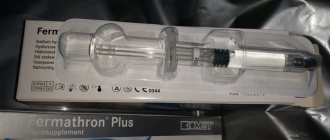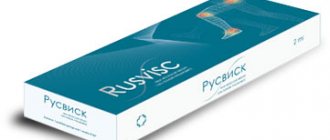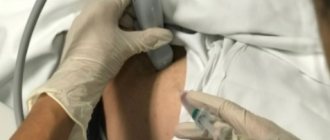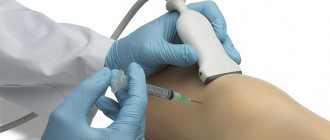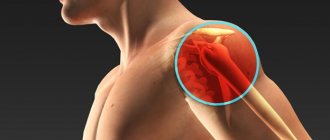Intra-articular injections are a therapy aimed at reducing symptoms associated with joint pain. These injections are sometimes called viscous additives. This method is an alternative to oral medications used for autoimmune diseases and diseases of the musculoskeletal system. The use of intra-articular injections replenishes lost lubrication, stimulates collagen production, relieves pain and swelling, and helps increase joint flexibility.
Intra-articular injection of synovial fluid endoprostheses (hyaluronic acid preparations)
Synovial fluid endoprostheses are drugs that are injected directly into the joint to protect articular cartilage from destruction, as well as to stimulate its recovery.
The active ingredient of these drugs is hyaluronic acid. Which is the main component of natural synovial fluid, which is normally produced in a person’s joint.
The synovial fluid itself performs the function of lubricating the joint, nourishing the cartilage and preventing it from wearing out.
When, for various reasons, this natural lubrication becomes less, the cartilage begins to deteriorate. The first signs of these processes are usually a crunch in the joints, later it is pain and discomfort when moving, redness and swelling of the joints, and later the joints change their shape, and any movement brings unbearable pain. And most often, the optimal solution in such situations is the introduction of hyaluronic acid, which will compensate for the lack of natural synovial fluid.
According to foreign researchers, almost 80% of patients with planned joint replacement surgery manage to postpone it.
And since 2003, therapy with hyaluronic acid preparations has been included in the recommendations of the World Health Organization for the treatment of osteoarthritis
Often, for joint diseases, ointments and tablet preparations are used, which in some cases only briefly relieve pain and inflammation, and do not affect the cause of the disease itself.
The use of intra-articular injection of synovial fluid prostheses is also explained by the fact that intra-articular injections, compared to tablets, firstly, create a high concentration of the drug directly in the affected joint, and secondly, have a faster effect.
The active ingredient of the drugs used - sodium hyaluronate - has lubricating and shock-absorbing properties, ensuring normal, painless movement of the joints.
Administration of the drug allows:
• “replenish the viscosity” of the intra-articular fluid of the affected joint, improve the quality of lubrication, which leads to the return of lubricating, shock-absorbing and filtering properties.
• trigger the mechanisms of natural production of hyaluronate by the joint.
• Reduce inflammation of the synovial membrane and restore its protective functions.
• protect articular cartilage from mechanical and chemical damage by restoring the protective coating on the inner surface of the joint and binding free radicals.
Slowing down the destruction of articular cartilage in combination with the processes of restoring homeostasis of the synovial fluid leads to rapid relief of pain symptoms and regression of the phenomena of limited mobility in the joint. The therapeutic effect lasts up to a year (depending on the stage of the disease), after which repeated administration of the drug is recommended. However, when combined with the use of the above method with physiotherapeutic treatment, osteopathy, and some other procedures, it is possible to significantly improve and prolong the effect of synovial fluid prosthetics.
The introduction of synoval fluid prostheses in the complex treatment of rheumatological diseases contributes to:
• slowing down the destruction of articular cartilage;
• restoration of synovial fluid in the joint;
• rapid relief of pain symptoms;
• reducing the phenomena of limited joint mobility
For questions about intra-articular injections, please call 8 910 198 11 11
All about intra-articular
infections in arthrosis: advantages and disadvantages
With arthrosis, the process of self-healing of cartilage tissue is disrupted, which invariably leads to abrasion, cracking, and ulceration of the intra-articular cartilage. Unfortunately, even the most modern oral medications that can restore the integrity of cartilage tissue act slowly: it takes about six months for the first results to appear, and this is with almost continuous use. Drugs for injection into the joint cavity have a number of advantages: they act much faster, do not affect the functioning of internal organs, and the active substance is completely delivered directly to the lesion. Intravenous and intramuscular injections are also used in therapy. Usually their use is justified in cases of rare exacerbations of osteoarthritis, when it is necessary to help a person quickly. For routine therapy, in most cases, such injections can be successfully replaced by taking the same drugs in the form of capsules, tablets or powders.
Intra-articular injections for joints
Intra-articular injections or injections are a procedure for introducing a drug into the cavity of a large or small joint.
It is an integral part of the conservative treatment of inflammatory (arthritis) and degenerative-dystrophic (arthrosis) diseases of the musculoskeletal system. It is worth noting that treatment of joints by intra-articular injections is not prescribed to all patients. Their use has strict indications and is prescribed by a doctor depending on the specifics and severity of the pathology. Do not be afraid of injections into the joint - the procedure for administering the medicine is not much different from intramuscular or intravenous injections and does not cause much discomfort. But the benefits of such therapy, if used correctly, can be significant - it will allow you to continue treatment with other methods, stop the development of joint disease, help avoid surgery or delay surgery. Corticosteroids, chondroprotectors and hyaluronic acid preparations are used for injections in medical practice. Most often, medications are injected into the knee, shoulder, and hip joints. Advantages and disadvantages of intra-articular drug administration The advantages of this method of drug administration are difficult to overestimate: drugs injected into the joint cavity dissolve very slowly (up to a year), have a local effect on all tissues of the joint, while practically do not penetrate into the blood and do not affect the functioning of internal organs. From this point of view, they are much safer and can be used even in patients with severe concomitant diseases, which make treatment with other methods simply dangerous. The main disadvantage is that the technique cannot be used to treat small or deeply located joints: the joint cavity must be large enough to insert a needle, and the joint must be accessible for injection. It is most convenient to give injections to the knee joints. Even with this administration of drugs, there is always a danger of infectious complications. Preparations in the form of intra-articular injections for the treatment of arthrosis
Glucocorticoid hormones Glucocorticoid hormones have a very powerful anti-inflammatory effect.
Injected into the joint cavity, already on the first or second day they lead to a significant reduction in pain, redness, and swelling in the affected area. The effect of injections for arthrosis lasts for 1–4 weeks, after which it fades away. Among the drugs in this group, injections of methylprednisolone, triamcinolone, and betamethasone are used. Despite their high effectiveness in treating severe pain and inflammation, these medications have one significant drawback: with constant use, they accelerate the destruction of cartilage. For this reason, treatment of arthrosis with hormones is carried out no more than 2 or 3 times a year. Injections of hormonal drugs, which include glucocorticoids, have been used in rheumatology and orthopedics for quite some time. This is one of the most common treatment options for arthritis, which is accompanied by inflammation and pain that cannot be blocked by other drugs. In addition, hormonal injections are used for arthrosis, which occurs with symptoms of synovitis - inflammation of the synovial membrane of the joint with the accumulation of fluid (effusion) in its cavity. Without eliminating the pathological process, it is impossible to begin other methods of conservative therapy, such as taking chondroprotectors, physiotherapy, massage or physical therapy. Corticosteroid injections: pros and cons
The most effective corticosteroids are Kenalog, hydrocortisone, flosterone, celeston,
diprospan
.
They relieve inflammation and instantly (within a few minutes) relieve pain. But corticosteroid drugs do not cure the disease and are not able to restore damaged cartilage tissue. In addition, they lead to microtraumas, causing the risk of infection entering the joint. Frequent injections into the knee inhibit regeneration processes in the joint, constrict blood vessels, promoting tissue destruction, and increase hypertension, peptic ulcers, and diabetes. Therefore, injections of corticosteroid hormones are given only during periods of severe exacerbations, if other means do not produce results. Drugs can be administered no more than once every 3-6 months. Hyaluronic acid preparations (Fermatron, Gialurom, Rusvisk)
Hyaluronic acid plays an important role in the formation of new cartilage.
It is an integral part of the cell membranes that produce connective cartilage tissue; it also gives the cartilage elasticity, and the intra-articular fluid – viscosity, sliding and lubricating properties. Hyaluronic acid preparations injected into the joint in the form of injections create favorable conditions for the rapid restoration of cartilage tissue. They improve shock absorption and facilitate the sliding of articular surfaces during movement, pain in the joint decreases, and range of motion increases. The drug remains in the joint cavity for many months (from 3 to 12), and all this time it has an effect. It is no secret that the peak incidence of arthrosis occurs in old age. But it is precisely in patients over 60 years of age that arterial hypertension and cardiovascular diseases (stroke, heart attack, angina) occur. Concomitant diseases often make it impossible to use effective drugs for pain and inflammation - NSAIDs. In such a situation, intra-articular injections with hyaluronic acid literally become a salvation: they reduce joint pain and significantly improve the quality of life of patients and do not have the side effects characteristic of NSAIDs. Intra-articular injection of hyaluronic acid is the preferred method of treatment when the patient suffers from peptic ulcers, erosive intestinal lesions, or takes glucocorticoid hormones orally or by injection (prednisolone, metypred, etc.). Hyaluronic acid may cause an allergic reaction in patients with chicken protein intolerance. Injections should not be given if the skin in the joint area is affected. All these points must be taken into account when planning treatment with intra-articular injections. Intra-articular injections of hyaluronic acid One of the most innovative and effective methods of treating osteoarthritis today is considered to be intra-articular injections of hyaluronic acid preparations, which are also called “liquid prosthesis”. Sodium hyaluronate is a natural component of synovial fluid, which prevents friction of bones in the joints, ensures physiological movements of the joint without pain and limitation of amplitude. Injections of hyaluronic acid restore the composition of the synovial fluid, thereby preventing the progression of arthrosis and eliminating its clinical manifestations. Intra-articular injections with drugs of this group are prescribed at any stage of the pathological process, although in advanced cases of the disease they are less effective than in the initial stages of development. What injections are given to restore the composition of synovial fluid. The most famous include: - Fermatron - Hyalurom - Rusvisk “Liquid prostheses” - this is what hyaluronic acid is called. It serves as a complete replacement for synovial fluid. Injections injecting hyaluronic acid form a thin film on the surface of the joint. It acts as a lubricant and protects the cartilage from damage and friction. Due to its ability to retain water, hyaluronic acid has a moisturizing and nourishing effect, protects the joint from drying out and makes the cartilage tissue elastic and elastic, improving leg mobility. Hyaluronic acid has no side effects and can be used for a long time. Its only drawback is its high cost. Usually 3-4 injections of medication are given per year. They give an effective result in the first and second degree of damage. At the third stage of arthrosis, the introduction of hyaluronic acid gives only a temporary effect. Complications of intra-articular injections
Like any medical intervention, intra-articular injections are associated with the risk of complications.
— Infectious (septic) arthritis, which is characterized by purulent inflammation due to infection during the procedure. The likelihood of developing pathology is higher with injections of glucocorticoids due to a decrease in the body's immune defense, which is caused by hormonal drugs. If the rules of asepsis are observed, the risk of infectious complications is minimized. It is also important to begin treatment after eliminating chronic foci of infection and acute inflammatory processes that cause the appearance of infectious arthritis. — Exacerbation of joint disease in the first few days after the injection, which is associated with the effect of the drug and usually goes away within a week. Sometimes an allergic reaction to the components of the injection solution develops, and the drug should be discontinued. — During the injection, joint tissue is injured, and frequent injections of glucocorticoids destroy cartilage, weaken ligaments and tendons, which leads to “looseness.” Intra-articular injections are effectively used to treat diseases of the musculoskeletal system and are prescribed in those clinical cases when other methods of conservative therapy ineffective. The choice of drug and duration of therapy is determined by the doctor after a diagnostic examination. How are intra-articular injections done?
An injection into a joint for arthrosis is performed only in the clinic by a traumatologist.
It is advisable to administer drugs into the joint under ultrasound control. After the injection, there may be redness, swelling and swelling in the joint area, as well as increased pain and stiffness. These symptoms may last for several hours or days. Injections for arthrosis have a cumulative effect. Their number depends on the stage of development of the disease. For minor joint damage, the effect appears fairly quickly. If the disease is advanced, treatment can last for months or years. It is recommended to inject hyaluronic acid and chondroprotectors in courses so that the body can start restoration processes in the joint. Each course consists of 10–20 procedures. Hyaluronic acid injections (Fermatron)
Recently, in medical practice, the technique of administering drugs into the joint by injection is often used.
This treatment method eliminates inflammation in the joints and prevents their deformation. Intra-articular injections into the knee joint have a unique risk effectiveness, which depends on the drugs used. The most popular and effective drugs for injection into the knee joint are those containing hormones. Thanks to corticosteroids, you can significantly reduce the symptoms of diseases, but nothing more. Hyaluronic acid, which is part of the treatment, helps restore the cartilage structure and improve the motor activity of the affected limb. These medications have a short-term or long-term therapeutic effect, depending on the diagnosis and general condition of the patient. Controversial and less effective methods of combating damage to the knee joints are tenosynovial injections and radioactive colloids. These methods are used very rarely, mainly when there are contraindications to the prescription of safer and more effective drugs. Injections of hyaluronic acid Hyaluronic intra-articular injections into the knee joint really significantly alleviate the patient’s condition. The use of this drug makes it possible to improve the viscosity of intra-articular fluid in case of arthrosis, which helps prevent damage to cartilage. The drug acts exclusively on the area of the joint into which it is injected, which prevents the development of side effects. Sodium hyaluronate has the following effectiveness: • Improvement of joint structure; • Restoration of joint fluid functions; • Facilitation of motor activity in the affected area. The high price of an injection into the knee joint with hyaluronic acid is the only drawback to this procedure. Conditions for administering intra-articular injections for arthritis: • Active form of the disease; • Injection of the drug into the most affected area; • Combination of therapeutic and analgesic therapies; • Comparison of harm and benefit. The need for prevention When carrying out intra-articular therapy, it is imperative to unload the affected joint and carry out secondary prevention aimed at suppressing the progression of the pathology. In the initial stages of the disease, it is possible to engage in cycling or swimming, which helps strengthen muscle mass, increasing the body's resistance. In case of severe symptoms, it is recommended to adhere to semi-bed rest with the average physiological position of the affected limb. Preventive measures that complement basic treatment with medications can significantly improve the patient’s condition. “Dispersing salts” while overcoming pain is not recommended, because this method of combating arthritis is erroneous, as it increases the pain syndrome, provoking an exacerbation of synovitis and aggravating arthrosis. Injections into the knee for arthrosis
Recently, unfortunately, the number of people who complain of periodic or constant severe knee pain, difficulty moving, and lameness when walking has been increasing. These symptoms belong to a common and quite dangerous disease - arthrosis, which affects the knee joints. The disease is characterized by the fact that under the influence of various factors (most often it is excessive load), the gradual destruction of the cartilaginous layer of the joint lining its internal part begins. As a result, friction between the bones occurs, which causes excruciating pain, inflammation, the formation of bone spines and other unpleasant consequences. This disease is dangerous because if it is not treated, a person may completely lose the ability to move. Treatment of this disease depends on the stage of its development and involves the use of medications, physiotherapy, exercise therapy and, if necessary, surgery. But surgery is always a risky, undesirable event that is best avoided if possible. Fortunately, there is such an opportunity - the use of intra-articular injections for arthrosis. This non-surgical treatment method offered by modern medicine is extremely effective. Its essence is that a drug is injected into the affected joint by injection, slowing down or stopping the process of destruction of cartilage tissue. Several types of drugs with different purposes are used for injection treatment. The main ones are corticosteroids, chondroprotectors, hyaluronic acid. Corticosteroids are unable to get rid of the disease itself, so they cannot be used independently. The need to use joint injections for arthrosis is due to the fact that these drugs have a powerful anti-inflammatory and analgesic effect. They can only relieve symptoms and have an auxiliary function in combination with the main methods of treatment. It should be noted that corticosteroids are hormonal substances that, despite all their effectiveness, have many side effects. They are not completely safe for the body, so they are prescribed only if non-steroidal drugs and conventional painkillers do not help, and this, as a rule, is already an advanced stage of the disease. The frequency and dosage of injections into the knee for arthrosis should be determined by a doctor. A number of rules must be followed to make hormonal therapy safe: • the frequency of injections is no more than 1 time every 3-5 months; • if after the first injection there is no anti-inflammatory or analgesic effect, this drug may not be suitable for you. The doctor will replace it with another one, however, if in this case the expected effect does not occur, this can be regarded as a contraindication to hormonal therapy; • insufficient pain relief may mean that the injection site is marked incorrectly. The injection site needs to be adjusted. Chondroprotectors The next type of injections for arthrosis, called chondroprotectors, are used to restore damaged cartilage. It is used only when there are no symptoms of inflammation. Chondroprotectors can be taken orally, but injections have undoubted advantages, since they act precisely and have a quick positive effect literally from the first time. The essence of the action of this drug is that when it gets inside the cartilage, the active substance stimulates the production of healthy cartilage cells, which replace damaged cells over time. Hyaluronic acid The action of hyaluronic acid is similar to the action of synovial fluid, which washes the joint and provides gliding. Acid does not replace cartilage, but it significantly facilitates movement and helps relieve inflammation and pain. Injections of hyaluronic acid for arthrosis of the knee joints are absolutely harmless; they are used in courses of 3-5 injections every 1-2 weeks, once a year. This drug is used both in complex therapy and outside of it.
Which drug should I choose?
There are quite a large number of hyaluronic acid preparations on the market for intra-articular administration. As a rule, the course consists of 1-3-5 injections, depending on the chosen drug, with an interval of 7 days. The effect of the drug lasts from 6 to 12 months from the date of administration. A rheumatologist will help you decide on the choice of a specific drug during a consultation, since this is influenced by a number of factors: the patient’s age and weight, the degree of narrowing of the joint space, the general condition of the joint, previous experience in using hyaluronic acid drugs, etc. Also An important factor is the price of the drug per course - from 4 to 15 thousand rubles
How does the procedure work?
The technique involves injecting a pharmacological agent directly into the area of the diseased joint. The entire procedure usually takes about 15 minutes and is typically a series of 3-5 injections spaced several days apart.
The exact duration of the course, schedule of procedures and type of drugs are determined on an individual basis and depend on the patient’s medical history. Most often, injections are given at intervals of 7 days.
Intra-articular injections are minimally invasive procedures. If you are hypersensitive to the components of the drug, redness or itching of the skin may occur. Some patients experience pain at the puncture site and slight dizziness. In most cases, the sensations with intra-articular injections are approximately the same as with intramuscular injections: the method uses a very thin needle, and there is no sensation of pronounced pain.
Before the procedure, the doctor thoroughly disinfects the patient’s skin. After administering the medicine, the doctor may ask you to make several movements of the joint so that the medicine is evenly distributed inside. Intra-articular injections do not require rehabilitation: after the procedure, you can continue to lead your usual lifestyle.
Sometimes additional visual examination is necessary for error-free and accurate administration of the drug. This is relevant, for example, in the case of administering drugs to the joints of the spine. In this case, ultrasound is used to accurately determine the joint space.
How are injections made?
Mandatory conditions for the administration of hyaluronic acid preparations are the absence of contraindications to their use, appropriate training of the doctor in the technique of intra-articular injections and strict adherence to the rules of asepsis and antisepsis. In our medical center, the administration of drugs is carried out by qualified rheumatologists with strict adherence to all safety rules for the patient.
Advantages
-Reduced pain syndrome
-improving quality of life
-alternative to joint replacement
- no side effects typical of NSAIDs
-possibility of use in patients suffering from peptic ulcers, erosive intestinal lesions, nephritis, or taking glucocorticoid hormones orally or by injection (prednisolone, metipred, etc.).
• Possibility of reducing the intake of NSAIDs and chondroprotectors
When to see a doctor?
We recommend that you do not delay visiting a specialist in the following cases:
- For arthritis or arthrosis. The maximum effect can be achieved by treating these diseases at an early stage. In advanced cases, the drug is necessary to stabilize the condition, reduce pain and prevent complications.
- If you have pain and discomfort in your knees while moving.
- After knee injuries.
Consultation with a specialist is also recommended for all elderly patients. To make an appointment with a doctor, call +7 (347) 216 00 22. Please note that a pediatric orthopedist in Ufa conducts consultations at our clinic.
